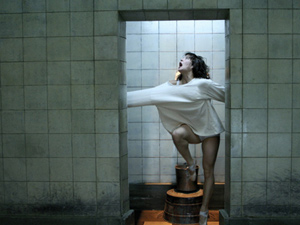La Chambre Blanche: mind-altered chaos

In her piece La Chambre Blanche, first choreographed in 1992, Ginette Laurin - choreographer of Montréal's O Vertigo dance company - doesn't merely choreograph a piece about madness and other related experiences, she evokes it, indeed almost invites the audience to join in the frenzy going on in the richly staged white room.
The set is a foreboding place; it is a built-up room with three walls that appear to be made of stone, a ceiling that is subtly and eerily lit, and at the back there is a door, an escape hatch of sorts, that leads who knows where. It is within these imperious, stark walls that the nine dancer/inmates move, at times chaotically, suggesting everything from paranoia and mania to fear and delusion. In some moments the choreography brings the dancers into intimate connection with each other, yet within this claustrophobic setting, the intimacy seems somewhat deranged, occasionally even violent.
The allusions to sanity/insanity are appropriate given that the themes of this piece were partly built around the massacre of 14 women at the École Polytechnique in Montréal in 1989. Recalling this event, a shudder of horror still runs up my spine, and I can understand Laurin's need to physicalize the terror, deep remorse and grief that was felt collectively across Canada on that horrible day. In referencing this event, Laurin's exploration must necessarily evoke the vulnerability of the human psyche and its capacity to be altered.
The dance itself includes a great deal of frenetic, discordant movement, and then moments of unison in which the dancers come together into temporary harmony. In both their isolation and their collaboration, however, the dancers convey a sense of being just over the edge of sanity. The pace of this show is, mostly, fast and the movements demanding, highly athletic, while the atmosphere, the background, includes a soundtrack of almost decipherable babbling and maniacal laughter. At one time the female dancers perform frenzied bourrées on pointe, as though highlighting their instability and vulnerability. One of the men is nearly catapulted over the wall, but fails to make it out, and the dancers later appear on stage wearing bunny masks that in some contexts would be hilarious, but here clearly references forays into insanity.
O Vertigo always provides audiences with excellent dance, creative choreography and interesting set, lights and soundtrack. Where this piece surpassed its own production values was in its ability to evoke the visceral and deeply individual, personal experience of an altered mind. In this Laurin is masterful, and her piece, with its highly kinetic and original choreography, is wonderfully illustrative of any number of conditions of the mind.
In the final scene, one of the dancers emerges from the back room wearing pointe shoes and a white shirt, designed to look like a straight jacket with long sleeves wrapped around and around her. As the sleeves come unraveled, the rest of the dancers use them as a prop, a dance partner; at one point the dancers almost seem to be dancing around a maypole using the sleeves as long ribbons anchoring them to the dancer who remains at the centre of all the frenzy. Finally the sleeves become so long that they extend through windows that appear, magically, in both sides of the walls, and the dancer in the centre seems suspended, perhaps permanently, in this place of psychic disturbance and mind-altered chaos.



